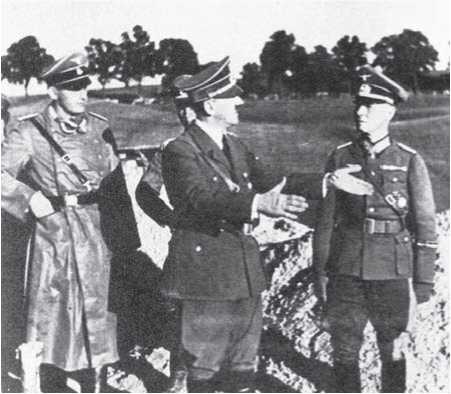
By late 1917 the German Army had nearly completed a major tactical reorganization. The new Stosstrupp tactics were based on deep infiltration of enemy lines, which required inspired, skilled and resolute commanders to enable the breakthrough of enemy positions. With Russia on the verge of collapse a new front was sought where these tactics could be tested, and Italy seemed the perfect choice. If the Germans managed to break through the Italian lines on the Isonzo River and reach Venice, they could then threaten the Po Valley and the heartland of Italy. This might knock her out of the war, and then their forces could shift to the Western Front. An Alpenkorps (mountain corps) was formed, and the WGB, along with the Koniglich Bayerische Infanterie-Leib-Regiment, was to storm a key position on the Italian line: the Kolovrat Ridge with its dominating height of Mount Matajur. After breaking through the Italian forward positions on 24 October 1917, on the 25th Rommel led his own detachment up Mount Matajur sweeping aside enemy positions, capturing hundreds of prisoners and getting close to the summit, which was too well defended to capture. Rommel changed the plans for the operation; while elements of
Rommel (at Left, with the camera hanging from his shoulder) had only three months to acquaint himself with his new command, 7. Panzer Division, before the German attack in the West started. (HITM)
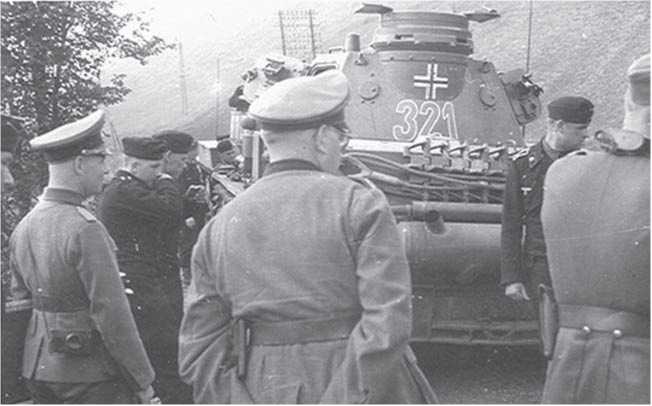
The Koniglich Bayerische Infanterie-Leib-Regiment dealt with Mount Kuk, he led four of his own companies down a trail to a valley behind Mount Matajur. Here he took even more prisoners (some 2,000) and rejoined the rest of the WGB, which had seized Mount Kuk and broken through the
River crossing played an essential role during the opening stage of the German attack across Belgium, which started on 10 May 1940, and Rommel was ruthless in using any available pontoon bridges. (HITM)
Italian lines. On the 26th Rommel stormed the nearby mounts Cragonza and Mrzli until the WGB's commander, Major Sproesser, believing the whole area was in German hands, ordered him to withdraw. Knowing his commander was wrong, Rommel disobeyed his order, and, taking some 100 men with him, he attacked the summit of Mount Matajur and seized it, taking hundreds more prisoners. At 11.40am flares were sent up to signal the position had been taken and the enemy defences ruptured decisively.
These events started the battle of Caporetto - a debacle for the Italian Army and a partial success for the German Army, which failed in its major goal of breaking through into the heartland of Italy. However, in the early days of November 1917 that goal seemed to be within their grasp.
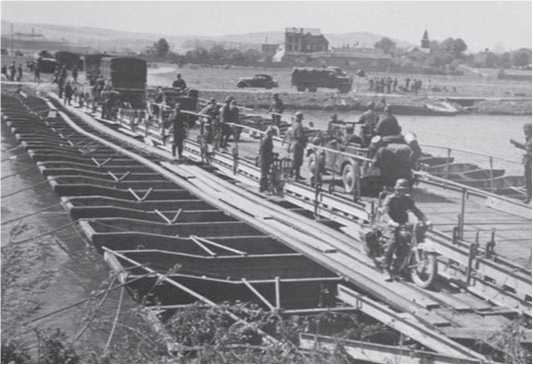
On 7 November, having crossed the Tagliamento River, Rommel was ordered to attack an Italian position covering a pass. This attack failed because, as Rommel himself pointed out, while he was busy organizing covering fire from machine guns, the infantry companies delayed their attack. This was not a mistake he would make again. Three days later Rommel's detachment crossed the Piave River and seized the town of Longarone, taking hundreds of prisoners again adding up to a total of over 10,000 since the beginning
ERW IN ROMMEL

Of the offensive. The Piave marked the limit of German advance. The offensive slowed and eventually came to a halt in November, with the WGB being transferred to the Grappa Massif where it found more determined enemies and was unable break through. In late November the WGB was pulled out of the line, returning on 17 December, and Rommel was granted leave back home.
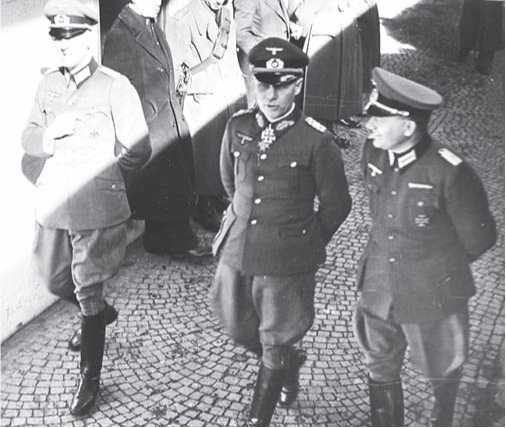
He would not return either to the WGB or to the front as on 11 January 1918 he was given a staff position at the HQ of LXIV Armeekorps.
The events of October-November 1917 would affect Rommel deeply, especially the matter concerning the award of
Rommel was appointed commander-in-chief of the Afrikakorps on 3 February 1941, and on the 12th he arrived at Tripoli. Note how he and the other officers are still wearing European-style uniforms, which were soon replaced by tropical ones. (HITM)
Germany's most important decoration: the Pour le Merite, also known as the 'Blue Max' after one of its earliest recipients in World War I, the air ace Max Immelmann. Rommel discovered accidentally that two other officers had been awarded the 'Blue Max' for the battles on the Kolovrat Ridge: Oberleutnant Ferdinand Schorner of the Koniglich Bayerische Infanterie-Leib-Regiment, who seized Mount Kuk, and Oberleutnant Walther Schnieber of Infanterie-Regiment 'von Winterfeldt' (2. Oberschlesisches) Nr. 23. Apparently Schnieber took Mount Colonna (behind Mount Matajur) and reported this to his HQ;
However, his message was altered, transforming him into the one who had seized Mount Matajur. The fact that both Schorner and Schnieber, unlike Rommel, belonged to the army's establishment probably had something to do with it. Deeply shaken, both Rommel and Sproesser protested vehemently up to the level of the Kaiser's cabinet. Eventually both were granted the award on 18 December 1918.
On 18 October 1918, shortly before the armistice of 11 November, Rommel was promoted to Hauptmann (captain). He was back with IR 124 on 21 December 1918 but, after it was disbanded, left in March 1919 to join Sicherheitskompanie 32 at Friedrichshafen to fight against a local uprising, which he did again in the areas of Musterland and Westfalen in the spring of 1920. On 18 October he swore allegiance to the Weimar Republic and, on 21 December 1921, joined the new Reichswehr and became commander of 4. Kompanie of IR 13 in Stuttgart.
His achievements and decorations were a key factor in assuring him a position with the new army, along with the fact that its rigid social structure had been definitively broken. The new Reichswehr was 100,000 strong and allowed only 4,000 officers; in 1914 the Reichsheer (Imperial German Army) possessed some 46,000 regular officers. Although some 11,500 of them were killed during the war, getting a job in the new army was extremely difficult, and once in the pace of promotion was extremely slow. The new chief of staff,
A column of PzKpfw IV tanks lined up in the streets of Tripoli, part of 5. leichte-Division's Panzer-Regiment 5. (Carlo Pecchi)
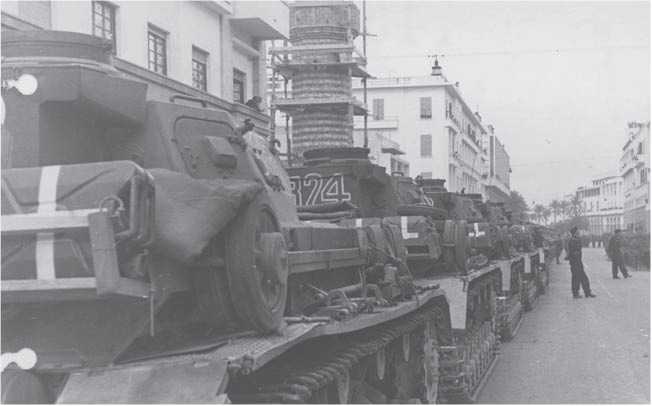
Rommel, wearing an Italian 'Sahariana' uniform, with General der Flieger Stefan Frohlich, the 'Fliegerfuhrer Afrika' (Luftwaffe commander in North Africa). (HITM)
Hans von Seeckt, was looking for officers with a general staff background who were capable of commanding above their actual rank. These abilities would ensure that the Reichswehr would be able to expand quickly once the limitations of the Treaty of Versailles were overcome. The Reichswehr therefore consisted of a strong core of experienced officers supported by a large intake of new officers, who would serve for only a limited period of time. Although the Kriegsakademie, the German Army's staff college, was closed down, the system remained in operation at local level. The fact that Germany no longer had a strong army but retained strong enemies, meant that it was vital that her limited army was a hotbed of innovation and intellectual development. These developments did not suit Rommel and his career stalled.
Like all other officers with 10 years of service, Rommel underwent an examination to test his professional ability. This lasted several days and included writing three different papers on tactics, several others on engineering, map reading and weapons and equipment, as well as answering
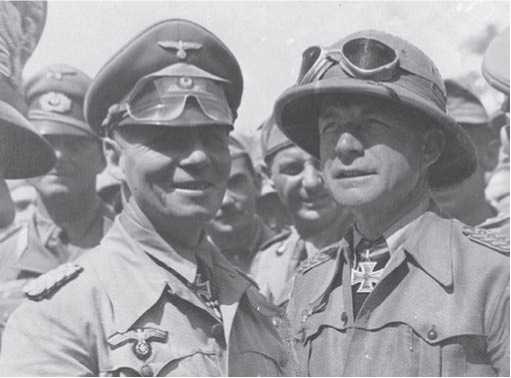
Questions on several subjects including military history, economics, geography, mathematics, physics and chemistry. Failure would result in the officer retaking the exam the following year; a second failure could lead to the officer losing his commission. The top 10-15 per cent were considered for general staff training, with only one in three actually making it through. Rommel was not amongst them, which is hardly surprising given both the selection rate and Rommel's academic aptitude.
The only major event in Rommel's life during these years was the birth of
A typical view from the Storch in April 1941: columns of German vehicles advancing at full speed along a desert track. (HITM)
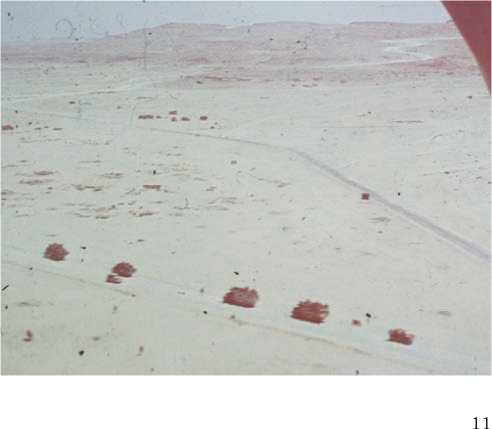
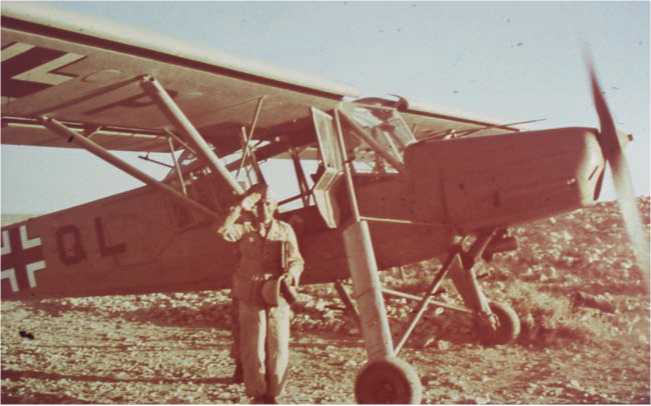
A Fieseler Fi 156 Storch, an aircraft Rommel used extensively during the first offensive in Cyrenaica in spring 1941. (HITM)
His son Manfred on 24 December 1918. Finally, on 1 October 1929 Rommel became a teacher at the Infanterieschule at Dresden, a position which enabled him to take full advantage of his experience and knowledge even though, as a colleague of his later recalled, he was not a great thinker. Promoted Major on 1 April 1932, on 1 October 1933 he had his first spell of command with III Battaillon of IR 17 at Goslar (the 'Goslarer Jager'). Here he met Adolf Hitler for the first time on 30 September 1934. On 1 March 1935 Rommel was promoted Oberstleutnant (lieutenant-colonel), and a few days later Hitler reintroduced conscription in Germany, which was the beginning of a new army. This brought no immediate change to Rommel's career and on 15 October he became an instructor at the Infanterieschule at Potsdam, which saw him attached to Hitler's military escort during the Nazi party's rally in the summer of 1936. From 7 January 1937 Rommel was without a position until on 25 February he was attached as the War Ministry's liaison officer to Baldur von Schirach, the leader of the Hitlerjugend (Hitler's youth organization), with whom Rommel had a difficult relationship. That same year Rommel also published his renowned book Infanterie Greift an (Infantry Attacks) which, other than being a personal recollection, was intended for use at war colleges and academies as a textbook. By 1945 it had sold some 400,000 copies. Promoted Oberst (colonel) on 1 October 1937, Rommel met Hitler again between 1 and 9 October 1938, during the German seizure of the Sudetenland, when he commanded the Fuhrerhauptquartier (Hitler's HQ) and escorted him personally. It was probably no coincidence that on 10 November,
Rommel became inspector of the coastal defences in north-west Europe on 5 November 1943, and it was thanks to his efforts that defences were greatly improved before the Allied landings on 6 June 1944. (HITM)
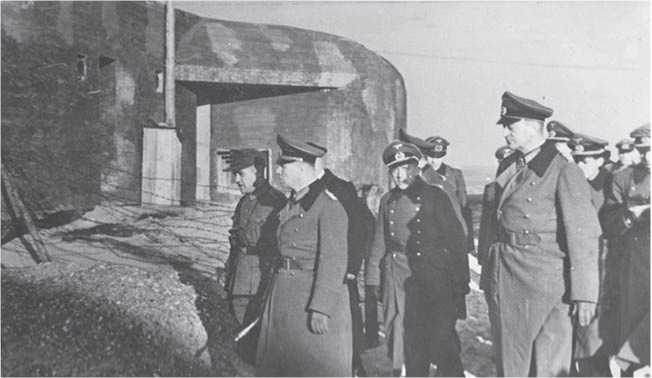
Rommel became commander of the Kriegsschule at Wiener Neustadt, a position he temporarily relinquished between 15 and 23 March 1939 to command the Fuhrerhauptquartier once more. Promoted Generalmajor (brigadier) on 1 August 1939, on the 23rd (at mobilization) Rommel was again commander of the Fuhrerhauptquartier during the campaign against Poland. Early in 1940 Hitler asked him what command he would like to have, and Rommel replied without hesitation: a Panzer division.
On 12 February 1940 Rommel took over command of the 7. Panzer-Division, which had been formed on 18 October 1939 from the 2. leichte-Division (a mixture of cavalry and armour) commanded by Generalleutnant Georg Stumme, who in September-October 1942 briefly replaced Rommel as commander of Panzerarmee Afrika. Of the ten commanders of Panzer divisions at the time, Rommel was the only one to have commanded neither a brigade nor a division, and also the only one not to see service during the Polish campaign.
Rommel's 7. Panzer-Division attacked across Belgium towards the Meuse on 10 May 1940, crossing in the area of Dinant. They advanced along with the 5. Panzer-Division, as both were part of Hermann Hoth's XV Armeekorps. By 12 May a bridgehead was established across the river, and, on the 15th, Rommel attacked westwards breaking through the French positions and smashing the bulk of French 1ere Division blindee in the process. In the early hours of 17 May the 7. Panzer-Division was across the Sambre River, like Guderian's Panzer divisions farther south. He then drove towards Cambrai (18 May) reaching Arras on the 20th; here on 21 May Rommel's 7. Panzer-Division faced the only major counterattack launched by the Allies after the German breakthrough. Led by British Matilda tanks it spread havoc amongst the Germans, though the situation was eventually restored and the counterattack repulsed with the loss of 36 Matildas.
On 23 May the division was at the Aa Canal, on the southern portion of the Dunkirk Pocket. Because of Hitler's 'halt order' the attack was not launched until the 26th and, the following day, the division was across the
Canal attacking towards Lille. At the end of May, before the surrender of
The remnants of the Allied forces in the pocket, the 7. Panzer-Division was pulled out of the line and Rommel counted his booty: 6,849 prisoners, 48 tanks captured and another 313 destroyed.
The second part of the campaign in the West started on 5 June, with
Rommel's 7. Panzer-Division attacking across the Somme between Amiens and Abbeville. After fierce fighting to break through the French defences, by 10 June the division had reached the sea at the port of St Valery, between Dieppe and Le Havre, where elements of an entire French corps and the 51st British Division surrendered on the 12th, with 12,727 prisoners being taken by the 7. Panzer-Division, a dozen generals included. On the 17th the division set out towards Cherbourg, which was reached on the 18th after an advance of some 240km (150 miles) in a single day. Fortress Cherbourg surrendered on 20 June, the following day the French signed an armistice with the Germans. Rommel's 7. Panzer-Division had captured 97,648 men, 277 field guns, 64 anti-tank guns, 458 tanks and armoured cars and more than 4,000 lorries since 10 May. Its losses were higher than any other
Panzer division: 682 killed, 1,646 wounded and 296 missing, plus 42 tanks permanently destroyed. On 17 and 21 May Rommel was awarded the 1939 clasps to his first - and second-class Iron Crosses, followed by the Knight's Cross on 27 May.
Rommel's career might have taken quite a different path had it not been for chance. Following Operation Compass in North Africa, which led to the British seizure of Cyrenaica and the destruction of an Italian army, Hitler decided to send a 'blocking formation' to prevent from British advancing to Tripoli. On 3 February 1941 Hitler replaced Hans von Funck with Rommel as the commander of the German force destined for Africa, which was at the same time increased to an entire corps, becoming the Deutsches Afrikakorps on 19 February. On 7 February Rommel was promoted Generalleutnant (major-general), and on the 12th he set foot on Africa's soil for the first time. He would spend two years here waging a see-saw campaign that would earn him fame and the nickname of the 'Desert Fox,' not to mention both promotions and decorations. Once Cyrenaica was reconquered, Rommel was
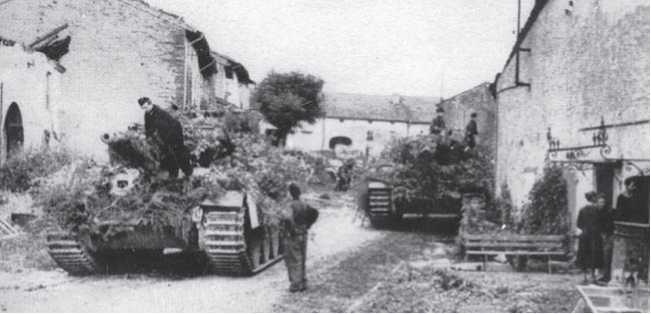
The central part of Rommel's defence plan against the threatened Allied invasion was the deployment of all the available Panzer divisions close to the threatened coast. (HITM)
Awarded the oak leaves to his Knight's Cross on 20 March and on 1 July he was promoted General der Panzertruppen (lieutenant-general); on 15 July Panzergruppe Afrika was formed with him in command. After the Axis forces were driven from Cyrenaica in December 1941, Rommel attacked again in January 1942 stopping only when he reached the defences of Tobruk. This second drive earned him the crossed swords to the Knight's Cross on 20 January and, on 30 January, promotion to Generaloberst (general), which coincided with the renaming of Panzergruppe Afrika as Panzerarmee Afrika. In May 1942 Rommel attacked the British Gazala Line in a battle that ended with the fall of Tobruk - which earned him promotion to Generalfeldmarschall (field marshal) on 22 June 1942 - and the drive to El Alamein, where the Axis forces would be beaten in November. After the retreat to Tunisia, on 23 February Rommel was given command of the newly formed Heeresgruppe Afrika, which he held until 9 March when left for Europe. On 11 March he was awarded the diamonds to his Knight's Cross.
On 15 July 1943 Rommel was given another command, that of Heeresgruppe B in northern Italy shortly before Mussolini's downfall and Italy's exit from the war. The idea was for him to take command in this new theatre, but eventually Hitler choose Kesselring instead and on 5 November Rommel was sent to northern France, first as inspector of the coastal defences and then, from 1 January 1944, as commander of Heeresgruppe B in north-west Europe. This put him once more on the front line when, on 6 June, the Allies landed in Normandy. On 17 July Rommel was wounded in an air attack on his car and was evacuated to Germany. Here he committed suicide on 14 October following his involvement in the plot to assassinate Hitler.




 World History
World History









